Hello World
依照惯例,我们从一个 Hello World 项目入手。
我们新建了一个名为hello-world的 Gradle 项目。
基于Form 表单的登录认证。
环境
- Gradle 3.4.1
- Spring Boot 1.5.2.RELEASE
- Thymeleaf 3.0.3.RELEASE
- Thymeleaf Layout Dialect 2.2.0
Gradle Wrapper
修改 Gradle Wrapper 的配置 gradle-wrapper.properties,使用最新的Gradle:
distributionBase=GRADLE_USER_HOMEdistributionPath=wrapper/distszipStoreBase=GRADLE_USER_HOMEzipStorePath=wrapper/distsdistributionUrl=https\://services.gradle.org/distributions/gradle-3.4.1-bin.zip
build.gradle
1. 自定义依赖的版本
我们可以自定义 Spring Boot 的版本,比如,我们使用了目前最新的 1.5.2.RELEASE 版本。
// buildscript 代码块中脚本优先执行buildscript {......ext {springBootVersion = '1.5.2.RELEASE'}// 自定义 Thymeleaf 和 Thymeleaf Layout Dialect 的版本ext['thymeleaf.version'] = '3.0.3.RELEASE'ext['thymeleaf-layout-dialect.version'] = '2.2.0'......}
2. 修改项目的名称
修改 build.gradle 文件,让我们的hello-world项目成为一个新的项目。
修改内容也比较简单,修改项目名称及版本即可。
jar {baseName = 'hello-world'version = '1.0.0'}
3. 修改项目的仓库地址
为了加快构建速度,我们自定义了一个国内的仓库镜像地址:
repositories {maven {url 'http://maven.aliyun.com/nexus/content/groups/public/'}}
4. 指定依赖
// 依赖关系dependencies {// 该依赖对于编译发行是必须的compile('org.springframework.boot:spring-boot-starter-web')// 添加 Thymeleaf 的依赖compile('org.springframework.boot:spring-boot-starter-thymeleaf')// 添加 Spring Security 依赖compile('org.springframework.boot:spring-boot-starter-security')// 添加 Thymeleaf Spring Security 依赖,与 Thymeleaf 版本一致都是 3.xcompile('org.thymeleaf.extras:thymeleaf-extras-springsecurity4:3.0.2.RELEASE')// 该依赖对于编译测试是必须的,默认包含编译产品依赖和编译时依testCompile('org.springframework.boot:spring-boot-starter-test')}
配置类
@EnableWebSecuritypublic class SecurityConfig extends WebSecurityConfigurerAdapter {....../*** 自定义配置*/@Overrideprotected void configure(HttpSecurity http) throws Exception {http.authorizeRequests().antMatchers("/css/**", "/js/**", "/fonts/**", "/index").permitAll() // 虽都可以访问.antMatchers("/users/**").hasRole("USER") // 需要相应的角色才能访问.antMatchers("/admins/**").hasRole("ADMIN") // 需要相应的角色才能访问.and().formLogin() //基于 Form 表单登录验证.loginPage("/login").failureUrl("/login-error"); // 自定义登录界面}......}
这段代码内容很少,但事实上已经做了很多的默认安全验证,包括:
- 访问应用中的每个URL都需要进行验证
- 生成一个登陆表单
- 允许用户使用用户名和密码来登陆
- 允许用户注销
- CSRF攻击拦截
- Session Fixation 攻击
- 安全 Header 集成
- 启用 HTTP Strict Transport Security
- X-Content-Type-Options.aspx) 集成
- Cache Control( 缓存控制 )
- X-XSS-Protection.aspx) 集成
- 集成 X-Frame-Options 来防止 Clickjacking
- 集成了以下 Servlet API :
- 所有匹配
/users/**的需要“USER”角色授权 - 所有匹配
/admins/**的需要“ADMIN”角色授权 - 基于 Form 表单登录验证的方式。登录界面指定为
/login,登录失败等会重定向到/login-error页面。如果不指定登录界面,则会Spring Security 会提供一个默认的登录页面:
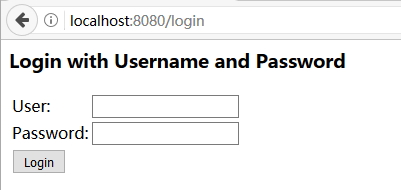
那幺,上述安全设置是如何默认启用的呢?我们观察下 SecurityConfig 所继承的 org.springframework.security.config.annotation.web.configuration.WebSecurityConfigurerAdapter类,其初始化的时候是这样的
http.csrf().and().addFilter(new WebAsyncManagerIntegrationFilter()).exceptionHandling().and().headers().and().sessionManagement().and().securityContext().and().requestCache().and().anonymous().and().servletApi().and().apply(new DefaultLoginPageConfigurer<HttpSecurity>()).and().logout();
也就是说,它默认的时候就隐式的启用了多安全设置。
再看下其他几个方法:
/*** 用户信息服务*/@Beanpublic UserDetailsService userDetailsService() {InMemoryUserDetailsManager manager = new InMemoryUserDetailsManager(); // 在内存中存放用户信息manager.createUser(User.withUsername("waylau").password("123456").roles("USER").build());manager.createUser(User.withUsername("admin").password("123456").roles("USER","ADMIN").build());return manager;}/*** 认证信息管理* @param auth* @throws Exception*/@Autowiredpublic void configureGlobal(AuthenticationManagerBuilder auth) throws Exception {auth.userDetailsService(userDetailsService());}
其含义为:
- 用户的认证信息是使用 InMemoryUserDetailsManager 来存储在内存中;
- 我们默认生成了两个用户,一个是“waylau” 是拥有“USER”角色权限;另一个是“admin” 是拥有“USER”以及“ADMIN”角色权限
运行
运行程序,访问http://localhost:8080 页面。
当我们试图访问以下页面时,提示需要用户登录:
- “用户管理”:对应 “/users” URL;
- “管理员管理”:对应 “/admins” URL
登录页面:
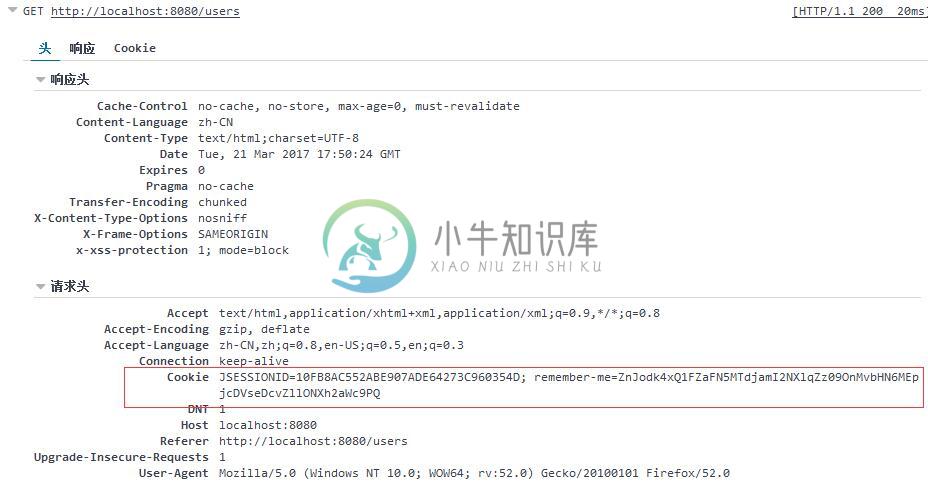
使用具有“USER”角色授权的“waylau”用户登录,可以访问“用户管理”页面:
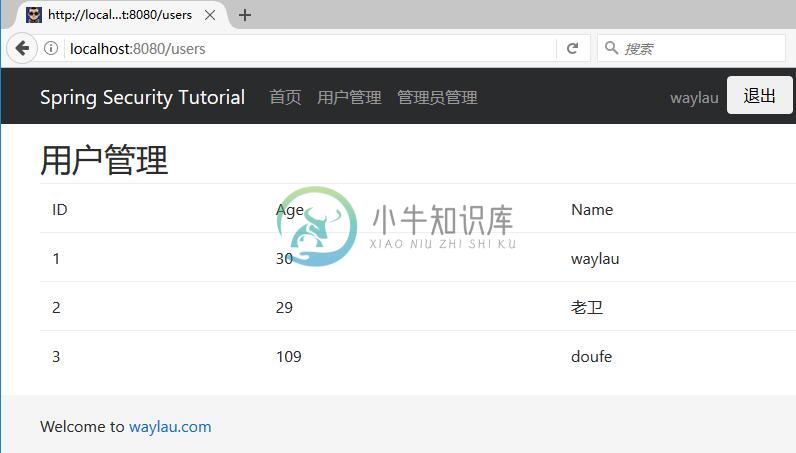
“waylau”用户登录可以访问“管理员管理”页面时,提示拒绝访问:
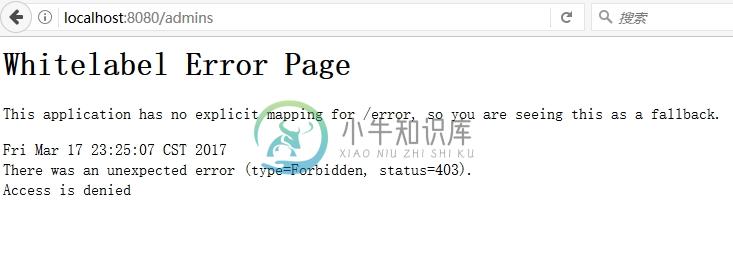
此时,我们换用 “admin”账号登录即可访问该页面。返回首页,我们能看到该用户的权限信息:
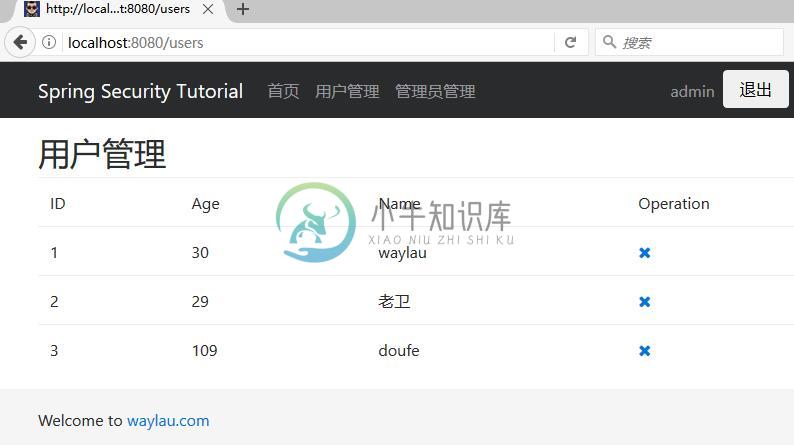
自定义 403 页面
默认的提示拒绝访问页面太丑,我需要自定义一个页面。我们在返回的页面里面提示“拒绝访问!”。
同时,我要在配置类里面,配置重定向的内容:
.......formLogin() //基于 Form 表单登录验证.loginPage("/login").failureUrl("/login-error") // 自定义登录界面.and().exceptionHandling().accessDeniedPage("/403"); // 处理异常,拒绝访问就重定向到 403 页面......
最终效果:
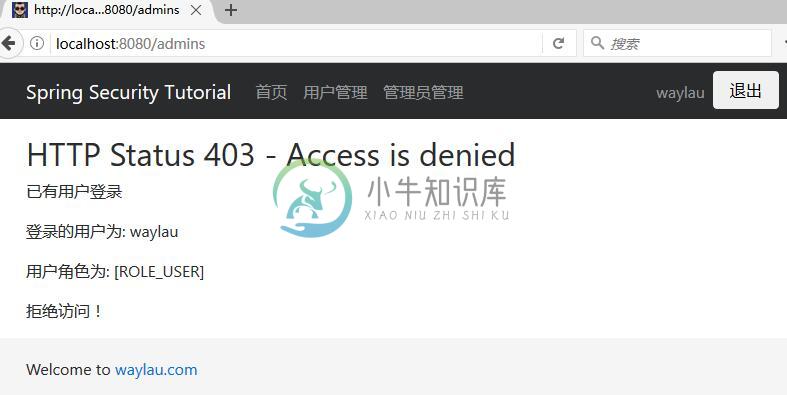
处理登出
使用WebSecurityConfigurerAdapter时,应用会自动提供注销功能。 默认情况下,访问 URL /logout来注销用户。注销动作,做了以下几个事情:
- 使 HTTP 会话无效
- 清除配置了 RememberMe 身份认证的信息
- 清除 SecurityContextHolder
- 重定向到
/login?logout
与配置登录功能类似,我们也可以使用各种选项进一步自定义登出要求,比如:
http.logout().logoutSuccessUrl("/"); // 成功登出后,重定向到 首页
这样,成功登出后,重定向到 首页。
其他的还可以选项还有很多:
protected void configure(HttpSecurity http) throws Exception {http.logout().logoutUrl("/my/logout") // 1.logoutSuccessUrl("/my/index").logoutSuccessHandler(logoutSuccessHandler) // 2.invalidateHttpSession(true) // 3.addLogoutHandler(logoutHandler) // 4.deleteCookies(cookieNamesToClear) // 5.and()...}
- (1)自定义触发登出的 URL
- (2)指定一个自定义LogoutSuccessHandler
- (3)指定在注销时是否使 HttpSession 无效。默认情况下是 true
- (4)添加 LogoutHandler。默认情况下,SecurityContextLogoutHandler 作为最后一个 LogoutHandler 被添加
- (5)允许指定在注销成功时要删除的 Cookie 的名称。这是一个显式添加 CookieClearingLogoutHandler 的快捷方式

